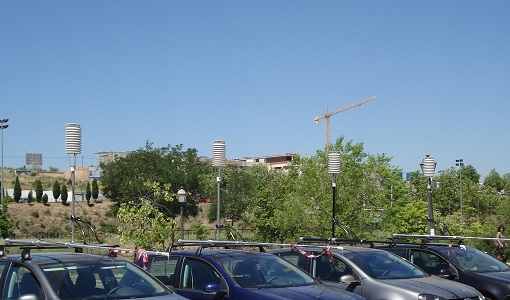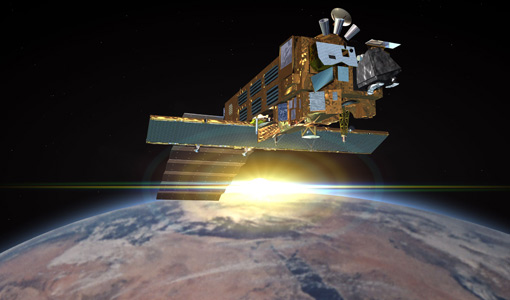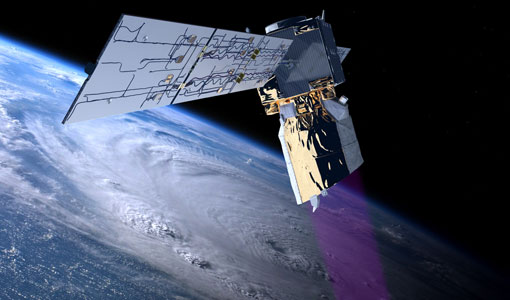- All Categories (62)
- Data (21)
- News (11)
- Missions (3)
- Events (11)
- Tools (2)
- Activities (7)
- Campaigns (3)
- Documents (4)
Document - General Reference
Envisat-ASAR-science-and-applications.pdf
This document describes the technical specifications of the Envisat ASAR instrument and its operations and objectives.
Document - Proceedings
SEASAR-2012-sessions-summaries-seed-questions-recommendations.pdf
This document gathers together the sessions summaries with seed questions discussion and recommendations of the SEASAR 2012 workshop.
Event - Conference
3rd ERS Symposium
The ESA Directorate for Observation of the Earth and its Environment held the 3rd ERS Symposium, in 1997, where many of the results from the ERS-1 and ERS-2 missions were presented and discussed by the scientific community.
Event - Conference
15 Years of Progress in Radar Altimetry Symposium
A Symposium on "15 Years of Progress in Radar Altimetry" and the annual meeting of the Ocean Surface Topography Science Team, the International Doris Service Workshop and the ARGO Workshop.
Event - Training
Advanced Training Course on Ocean Remote Sensing 2006
The objective of the course was to provide first-hand information on a broad range of ocean research topics including key principles of SAR, Radar Altimetry, Ocean Colour and Sea Surface Temperature measurements, processing algorithms, data products and their use in oceanographic applications.
Event - Conference
Living Planet Symposium 2019
ESA's Living Planet Symposia are amongst the biggest Earth observation conferences in the world. Scientists present their latest findings on Earth's environment and climate.
Event - Meeting
AGU Fall Meeting 2019
The 2019 AGU Fall Meeting offered the opportunity to participate in AGU's centennial presentations and special events that brought to life the past, present and the future of AGU's science.
Campaign
CHARADMexp
The ESA CHARADMExp campaign focuses on marine and marine-dust aerosol mixture characterisation.
Campaign
C-MAPExp
The C‐MAPExp campaign was planned and executed to support the demonstration of CarbonSat capabilities.
Campaign
DESIREX 2008
DESIREX 2008 (Dual-use European Security IR Experiment 2008) was conceived as an experimental campaign in the city of Madrid (Spain).
Mission - Heritage Missions
ERS
The ERS programme was composed of two missions, ERS-1 and ERS-2, which together observed the Earth for 20 years, from 1991 to 2011.
Mission - Heritage Missions
Envisat
Envisat was ESA's successor to ERS. Envisat carried ten instruments aboard for a wide range of Earth observing fields. The mission was operational from 2002 to 2012.
Mission - Earth Explorers
Aeolus
The Aeolus mission which was launched into space on 22 August 2018 and was retired on 30 April 2023, provided global observations of wind profiles from space to improve the quality of weather forecasts, and to advance our understanding of atmospheric dynamics and climate processes.
Data - EO Sign In Authentication (Open)
Envisat ASAR AP Medium Resolution L1 [ASA_APM_1P]
This ASAR Alternating Polarization Medium Resolution Image product has been generated from Level 0 data collected when the instrument was in Alternating Polarisation Mode. The product has lower geometric resolution but higher radiometric resolution than ASA_APP and contains one or two co-registered images corresponding to one of the three polarisation combination sub modes (HH and VV, HH and HV, VV and VH). This product has been processed using the SPECAN algorithm and contains radiometric resolution good enough for ice applications and covers a continuous area along the imaging swath. The ASAR AP L0 full mission data archive has been bulk processed to Level 1 (ASA_APM_1P) in Envisat format with the IPF-ASAR processor Version 6.03. Spatial Resolution: 150 m ground range x 150 m azimuth.
Data - EO Sign In Authentication (Open)
Envisat ASAR AP Precision L1 [ASA_APP_1P]
This ASAR Alternating Polarisation Mode Precision product is generated from Level 0 data collected when the instrument is in Alternating Polarisation Mode (7 possible swaths). The product contains two CO-registered images corresponding to one of the three polarisation combination submodes (HH and VV, HH and HV, VV and VH). This is a stand-alone multi-look, ground range, narrow swath digital image generated using the SPECAN algorithm and the most up to date auxiliary information available at the time of processing. Engineering corrections and relative calibration (antenna elevation gain, range spreading loss) are applied to compensate for well-understood sources of system variability. Generation of this product uses a technique to allow half the looks of an image to be acquired in horizontal polarisation and the other half in vertical polarisation and processed to 30-m resolution (with the exception of IS1). Absolute calibration parameters are available depending on external calibration activities and are provided in the product annotations. Spatial Resolution: 30 m ground range x 30 m azimuth.
Data - EO Sign In Authentication (Open)
Envisat ASAR AP Single-Look Complex L1 [ASA_APS_1P]
This product is a complex, slant-range, digital image generated from Level 0 data collected when the instrument is in Alternating Polarisation mode. (7 possible swaths). It contains two CO-registered images corresponding to one of the three polarisation combination submodes (HH and VV, HH and HV, VV and VH). In addition, the product uses the Range Doppler algorithm and the most up to date processing parameters available at the time of processing. It can be used to derive higher level products for SAR image quality assessment, calibration and interferometric applications, if allowed by the instrument acquisition. A minimum number of corrections and interpolations are performed on the data in order to allow the end-user maximum freedom to derive higher level products. Complex output data is retained to avoid loss of information. Absolute calibration parameters are available depending on external calibration activities and are provided in the product annotations. Spatial Resolution: Approximately 8m slant range x approximately 4m azimuth.
Data - Fast Registration with immediate access (Open)
Envisat ASAR Wave SLC and Cross-Spectra Imagettes L1 [ASA_WVI_1P]
This is the basic Level 1B ASAR Wave Mode product, including up to 400 single-look, complex, slant range, imagettes generated from Level 0 data and up to 400 imagette power spectra computed using the cross-spectra methodology. The auxiliary parameters used are the most up-to-date at the time of processing. A minimum number of corrections and interpolations are performed in order to allow the end-user maximum freedom to derive higher level products. Complex output data is retained to avoid loss of information. Absolute calibration parameters, when available (depending on external calibration activities), are provided in the product annotations. Imagette power spectrum is equivalent to the ERS UWA (Near Real Time) product with revisited algorithm (cross-spectra) taking into account the higher quality of the SLC imagette. Note that starting from an SLC imagette, the generation of an ERS UWA-type product might be ensured by a simple look detection and summation. This product provides a continuation of the ERS-SAR wave mode data. Imagette Spatial Resolution: 20 m ground range x 20 m azimuth. Cross Spectra Output: Wavelength range from 20 to 1000 m in 24 logarithmic steps.
Data - Data Service Request (Restrained)
Envisat ASAR WS L0 [ASA_WS__0P]
The WS Mode Level 0 product consists of time-ordered AISPs collected while the instrument was is in Wide Swath Mode. The echo samples in the AISPs have been compressed to 4 bits per sample using FBAQ. This is a high-rate, wide swath (ScanSAR) mode so data is only acquired for partial orbit segments and is composed from five image swaths (SS1 to SS5). The Level 0 product is produced systematically for all data acquired within this mode. The objective of this product is to offer Level 0 data for possible image processing on another processing site. It includes mandatory information for SAR processing. Data Size: 400 km across track x 400 km along track.
Data - Fast Registration with immediate access (Open)
ERS-2 GOME Total Column Amount of Trace Gases Product
GOME Level 2 products were generated by DLR on behalf of the European Space Agency, and are the end result of the Level 1 to 2 reprocessing campaign of GOME Level 1 version 4 data with Level 2 GOME Data Processor (GDP) version 5.0 (HDF-5 format). The GOME Level 2 data product comprises the product header, total column densities of ozone and nitrogen dioxide and their associated errors, cloud properties and selected geo-location information, diagnostics from the Level 1 to 2 algorithms and a small amount of statistical information.
Data - Fast Registration with immediate access (Open)
GOME Total Column Water Vapour Climate product
The GOME Total Column Water Vapour (TCWV) Climate product was generated by the Max Planck Institute for Chemistry (MPIC), and the German Aerospace Center (DLR) within the ESA GOME-Evolution project. It is a Level 3 type product containing homogenized time-series of the global distribution of TCWV spanning over more than two decades (1995-2015). The data is provided as single netCDF file, containing monthly mean TCWV (units kg/m2) with 1-degree resolution, and is based on measurements from the satellite instruments ERS-2 GOME, Envisat SCIAMACHY, and MetOp-A GOME-2. Details are available in the paper by Beirle et al, 2018. Please also consult the GOME TCWV Product Quality Readme file before using the data.




